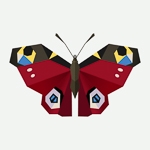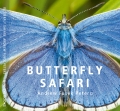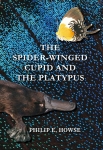R Resident or Regular Migrant
E Extinct
M Rare Migrant
V Vagrant
U Uncertain
A Adventive
Q Questionable
 |
The UK Butterflies 2024 Photography Competition is now open for entries! In keeping with the online nature of the UK Butterflies website, the competition itself will be conducted entirely over the web. The competition closes on November 30th and the winning photos will be announced in early December. The competition is supported by Greenwings, the UK Butterflies sponsor, and the winner will receive a copy of the excellent Close-Up - The Complete Guide to Macro Photography by Matt Doogue. Click here for information on how to enter. |
 |
From the publisher: Pyralid and crambid moths are amongst the most studied and readily encountered moths in the British Isles, and include some very attractive species. Whilst many are restricted in distribution within the British Isles, others are ubiquitous; they also feature prominently in migration events and occur as imports. This work represents the first comprehensive review of these moths since 1986 and brings together a wealth of knowledge about identification, distribution, flight periods and life cycle. Click here to read the review by Andy Mitchell. |

The UK Butterflies team is delighted that Greenwings has agreed to sponsor the UK Butterflies website for another 3 years. Pete Eeles says: "The long-standing relationship that UK Butterflies has with Greenwings is testament to our shared values, with both organisations promoting Lepidoptera conservation through our respective activities. Of course, we are delighted that the sponsorship will allow UK Butterflies to continue to grow and support the tens of thousands of individuals that visit the website each year".
 |
From the publisher: This is a photographic identification guide to 122 butterfly species and a selection of moths most commonly seen in Borneo (covering Sabah, Sarawak, Brunei and Kalimantan). Honor and Cosmo Phillipps' high quality photographs are accompanied by detailed species descriptions, which include nomenclature, wingspan, habits and habitat, larval foodplants and range. The user-friendly introduction covers a family tree for lepidoptera, where to see the butterflies, the Bornean environment, life cycle, parts of a butterfly, wing patterns and butterfly behaviour. Egg sizes, common larval food plants and nectar plants are also described and illustrated. Click here to read the review by Guy Padfield. |
 |
From the publisher: This book showcases the extraordinary range of colors and patterns of the world's butterflies while exploring their life histories, behavior, habitats and resources, populations, seasonality, defense and natural enemies, and threats and conservation. With remarkable photography, graphic illustration, and profiles of thirty-five selected species, this comprehensive and inviting book discusses dozens of key topics, including eggs, caterpillars, and chrysalids; flight, feeding, courtship, and mating; migration and hibernation; concealment, mimicry, and predators; habitat loss and fragmentation, climate change, and pesticides; and farming and gardening to support and attract butterflies. Click here to read the review. |
 |
From the publisher: This book documents, celebrates and shares the many successes the Warwickshire Branch of Butterfly Conservation has had in conserving our rarer butterflies over the past 25 years. It is a manual of techniques, tips and ideas that will help and hopefully inspire others to create and manage habitats and to conserve butterflies. In addition, the book outlines the fieldcraft that is required to provide the best chance of finding adult butterflies and their immature stages, provides tips on how to identify the difficult species and suggests how to get the maximum enjoyment from your butterfly encounters. Click here to read the review. |
 |
From the publisher: The app contains detailed descriptions of the 168 butterfly species found in northern Europe, from northern France in the south to Greenland in the north. Written by butterfly experts Lars Andersen and John Vergo, the meticulous content covers everything from a species' appearance to its distribution and habits, illustrated with photos of the male, female, eggs, caterpillars and host plants, together with flight period charts and distribution maps. Click here to read the review by David Moore. |
 |
From the publisher: A pictorial celebration of UK butterflies, this new title showcases moments rarely captured with such craft. Alongside his detailed photography, Andrew Fusek Peters describes the natural traits and challenges of each species he encounters, covered in dedicated chapters and ordered chronologically through the course of the year. Click here to read the review. |
 |
Congratulations to Dave Miller, overall winner in the 2022 UK Butterflies Annual Photography Competition! With an incredible shot of a pair of Brimstones, Dave wins a copy of Discovering Scotland's Butterflies by Paul Kirkland. Thanks to all the competitors - click here to see all of the winning entries. |
 |
From the publisher: This book develops and extends the author's views about the evolution and defensive aspects of mimicry in butterflies and moths set out in Seeing Butterflies; focusing on some of the most incredible insect mimicry that exists in tropical forests throughout the world. It reveals what no museum collection can tell us about the evolution of mimicry that has produced creatures that can be mistaken by predators for dead leaves, toxic beetles, scorpions, venomous snakes, lizards, frogs, bats, or insect-eating birds. Click here to read the review by Hugh D. Loxdale. |
 |
From the publisher: This book chronicles the life of the Reverend Arthur Miles Moss, a little-known genius who explored the Amazon, collecting and breeding butterflies and moths in period from 1903 to 1947 - a period during which little about the Amazon and its natural history became known to the world. Following in the wake of great Victorian naturalists such as Wallace and Bates, Moss' story has been neglected: apart from his publications in scientific journals he left a collection of 25,000 insects, unpublished manuscripts on Amazonian natural history, and some incredibly beautiful water-colours of bizarre-looking caterpillars now archived in the Natural History Museum in South Kensington. Click here to read the review by Geoff Bateman. |
 |
From the publisher: Scotland is an exciting place for butterfly-watching. The rapidly changing distribution of many species creates an enthralling environment for recorders and nature-lovers, while remote glens and islands undoubtedly hold undiscovered rarities. Discovering Scotland's Butterflies is for everyone who gets a buzz from seeing a butterfly, providing details of life cycles, habitats, ecology and distribution of the thirty plus species. Numerous anecdotes illustrate the pleasure to be gained from watching common butterflies or the thrill of discovering scarce ones. Click here to read the review. |
All News Items ...











